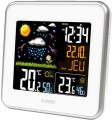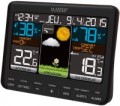Number of sensors
— Number of sensors. The total number of sensors that can be linked to the weather station and send measurements to it. The presence of
several sensors allows you to determine the weather conditions in different areas: these can be different rooms of the same building or different parts of the world. The location of the sensors relative to the structure can significantly change the accounts, therefore, to achieve more reliable results, 2 or more remote sensors are usually provided.
Form factor
External representation of the weather station allows you to better fit the model into the interior of the room according to your preferences and taste. Among the models are
square,
round and horizontal of two types —
horizontal and
vertical.
Transmitter power source
This concerns how the transmitter in the external sensor of a weather station is powered, specifically for wireless sensor models. Wired sensors, as mentioned earlier, don't have transmitters; they derive the required energy for operation through a wired connection.
The majority of models use sensors powered by standard-sized, replaceable batteries — either disposable or rechargeable cells. This choice is driven by considerations of battery life and the convenience of swiftly swapping out depleted batteries without removing the entire sensor. While this method incurs additional costs for separate battery purchases — either ongoing expenses for disposables or a relatively higher upfront cost for rechargeables—these drawbacks are generally deemed non-critical. Overall, the advantages of this approach outweigh these concerns for several reasons.
Dimensions
Dimensions of the main unit of the weather station. This option allows you to estimate the space required to install the device. However, most modern models are very compact, it makes sense to pay close attention to the dimensions only when you have to install the device in a very cramped place.
Transmitter dimensions
Dimensions of the wireless unit (see "Type of external sensor") that the weather station is equipped with. Such units are usually small, and finding space for their installation is not a problem; however, in some situations (for example, when placed in a miniature wall niche), accurate dimensions may not be superfluous.
Weight
The total weight of the device. In models equipped with external sensors, this parameter is usually indicated only for the main unit, because the weight of the external equipment is small and can be neglected.

